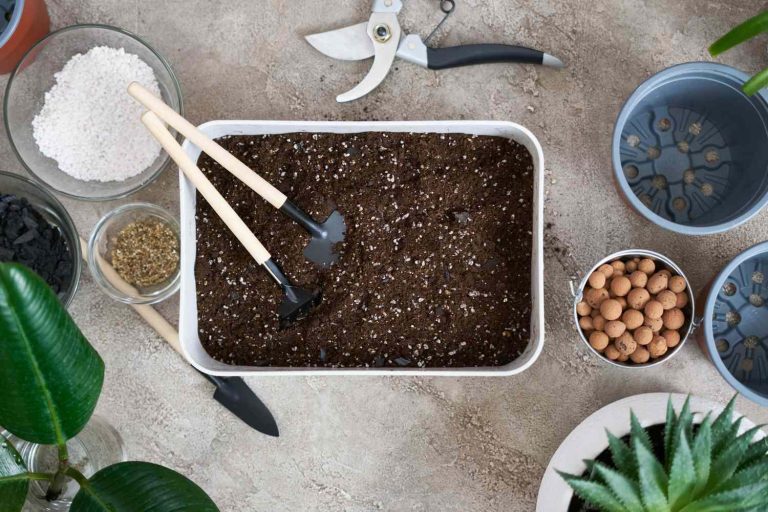As any avid gardener knows, keeping plants happy and healthy is the number one goal in all types of plant care, whether it's container gardening, houseplant care, or bed gardening. One useful material to add to your gardening routine is perlite. This is a substance that can be mixed into the soil and can help with everything from proper drainage to healthy root development. We spoke to two gardening experts to find out what perlite is, how it works, and how you can use it in your own garden.
- susan brandtco-founder of Blooming Secrets
- tony o'neilhorticulture expert, author, and educator
What is perlite?
Perlite is a volcanic glass commonly used in gardening because of its lightweight, porous nature, which aids in healthy plant development. “It's made from a type of volcanic glass called obsidian,” says Blooming Secret co-founder Susan Brandt. “When obsidian is heated to high temperatures, it expands and forms small white granules with many small air pockets.”
Brandt says gardeners often add perlite to their gardens. This is because the air pockets in perlite aid drainage and aeration, leading to improved soil structure, enhanced root development, and reduced likelihood of waterlogged conditions that can cause root rot. Perlite can be purchased at garden centers, nurseries, hardware stores like Lowes and Home Depot, or online at Amazon.
Types of perlite
There are several types of perlite that you can choose depending on your gardening needs. These range from coarse perlite to very fine perlite, as well as some specialized types.
coarse perlite
Coarse perlite, consisting of larger particles, is suitable for preventing waterlogged conditions both in potted plants and garden beds. “Coarse perlite with large particles is good for increasing aeration in potting mixes and is often used for plants that require well-drained soil, such as succulents,” says gardening expert, author, and educator. says Tony O'Neill.
fine perlite
Fine perlite has much smaller particles and is “often mixed with potting soil or other growing media to increase moisture retention,” Brandt says. “It provides a lightweight structure that allows the roots easy access to air and nutrients,” O'Neill said, adding that it is often used for germination because it is gentle on delicate roots.
horticultural perlite
You may find perlite labeled as horticultural perlite at garden centers. This type of perlite is specially processed for home gardening, Brandt says. “When heated to high temperatures, it expands and becomes lighter,” she says. “This type of perlite is perfect for seeding, propagation, and cuttings.”
agricultural perlite
Home gardeners will not need agricultural perlite formulated for large-scale agricultural operations. Agricultural perlite is used “as a soil conditioner to improve drainage and increase water holding capacity,” Brandt said. “It can be blended with a variety of substrates for hydroponic systems or mixed into soil to promote plant growth.”
Benefits of using perlite
Adding perlite to your garden soil can help keep your plants happy in several ways. In addition to improving soil drainage and aeration, O'Neill says, “it prevents soil compaction, allowing roots to grow freely and access oxygen more efficiently.” “Additionally, perlite can hold water on the surface, providing moisture to plant roots while preventing the soil from becoming soggy.”
aids root development
Perlite has the ability to help aerate the soil, giving your plants more space to spread out. “Their structure promotes root growth and development by providing a loose, well-drained environment that allows roots to grow freely,” Brandt says.
pH is neutral
When you add perlite to the mix, you don't have to worry about upsetting the natural pH of your soil. Perlite is considered pH neutral and can be used for a variety of plants with different soil acidity requirements.
Helps prevent disease
Disease prevention is always a top priority for gardeners, and using perlite can actually help with that. “Due to its non-organic nature, perlite does not provide a favorable environment for pests and diseases to breed,” Brandt says. “Using perlite in the garden can reduce the risk of plant diseases caused by pathogens present in organic matter.”
work for years
Rest assured that when you add perlite to your garden soil, you will reap its benefits for a very long time. Perlite does not decompose easily. “One of the main benefits of perlite is its durability. It doesn't degrade over time, so it helps maintain soil structure over the years,” O'Neill says.
Disadvantages of using perlite
Although there are several benefits to using perlite, there are also some drawbacks to be aware of. For example, perlite does not retain enough nutrients in the soil due to its drainage ability. “Regular fertilization is necessary to ensure that plants receive proper nutrition,” Brandt says.
Perlite is dusty, so be sure to wear a mask when adding it to the soil. Additionally, since perlite is made from a non-renewable resource, environmental sustainability must be kept in mind, O'Neill says.
How to use perlite in the garden
I bought a bag of perlite. What's next? Here are some of the most useful uses for perlite in the home garden.
- Starting seeds: If you want to start seeds indoors, adding perlite can be very helpful. “Its lightweight nature allows air to circulate around the seeds, providing optimal conditions for germination,” Brandt says.
- Container gardening: Plants grown in containers require more help with soil drainage than plants grown in garden beds. “Adding perlite to your potting mix allows excess water to easily drain away, preventing root flooding and promoting healthy plant growth,” Brandt says.
- Root propagation: “Perlite is a great tool for propagating plants from cuttings or for dividing root-bound plants,” Brandt says.
- Top dressing: Sprinkling perlite over the soil of potted plants acts as a protective barrier and keeps the soil moist longer.

